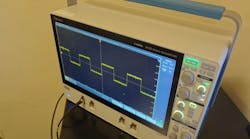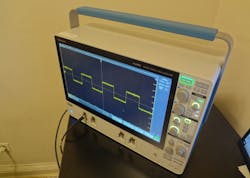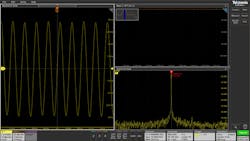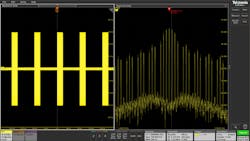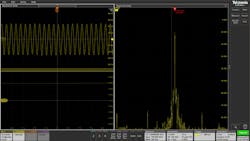Download this article in PDF format.
When discussing oscilloscopes, Tektronix is a name that will likely come up thanks to the company’s long history with this ubiquitous test instrument. While Tektronix has been in the business of manufacturing oscilloscopes for many years, the company continues to push the technology bar higher with its latest products and innovations.
For example, last year, I wrote about Tektronix’s 6 Series MSO Oscilloscopes, which were introduced right about that time. The 6 Series MSO instruments offer a bandwidth as high as 8 GHz along with 25-Gsample/s sample rates.
Here, I’ll present a closer look at the 6 Series MSO oscilloscopes, since Tektronix was kind enough to loan me one (Fig. 1). Specifically, this article explores a significant feature known as Spectrum View, which brings mixed-domain analysis to the 4, 5, and 6 Series MSO oscilloscopes. Spectrum View makes it possible to not only perform time- and frequency-domain analysis at the same time, but independently optimize displays of both domains. That means changing the measurement settings in one domain has no effect on the other.
1. Here’s the 6 Series MSO oscilloscope featured in this article.
A Quick Introduction
First, let’s take a quick general look at the 6 Series MSO oscilloscope. When using one of these instruments, one can’t help but notice the aesthetic 15.6-in. display. A significant aspect of these instruments is touchscreen operation, which will likely appeal to those who are accustomed to using smartphones and tablets (i.e., most anyone reading this article). Of course, the familiar knobs and buttons can still be used. Furthermore, those who may not be in favor of touchscreen operation can connect a mouse and/or keyboard to a 6 Series MSO oscilloscope as an alternative means of operating the instrument.
The oscilloscopes come equipped with various triggering techniques. Among them are Edge, Pulse Width, Timeout, Runt, Window, Logic, Setup & Hold, Rise/Fall Time, Bus, and Sequence. The 6 Series MSO oscilloscopes also feature visual triggering, which enables users to build complex waveform triggers by simply drawing shapes using the touchscreen or a mouse.
Another aspect worth mentioning is the optional integrated arbitrary function generator (AFG), which, according to Tektronix, is ideal for simulating sensor signals within a design or adding noise to signals to perform margin testing. The AFG provides various predefined waveforms at frequencies as high as 50 MHz. Waveform types include Sine, Square, Pulse, Ramp, DC, Noise, Sin(x)/x, Gaussian, Lorentz, and more. Furthermore, the AFG can load waveform records from an internal file location or a USB mass-storage device. The AFG feature is compatible with Tektronix’s ArbExpress PC-based waveform creation and editing software.
Frequency-Domain Analysis with Spectrum View
Tektronix introduced the Spectrum View feature earlier this year. For those already using the 5 and 6 Series MSO oscilloscopes, simply upgrading the firmware enabled access to Spectrum View. Of course, Spectrum View is included right out of the box for new 5 and 6 Series MSO oscilloscopes, and it’s also an optional feature for the new 4 Series MSO instruments.
Once again, the Spectrum View analysis tool makes it possible to simultaneously view time- and frequency-domain displays. Tektronix speaks very highly of Spectrum View, stating that it represents “a new approach to frequency-domain analysis on oscilloscopes.” But how does Spectrum View measure up? To answer that question, let’s see it in action.
Figure 2 shows the time-domain waveform of a 2.4-GHz continuous-wave (CW) signal with the horizontal scale set to 400 ps/div. Also shown is the corresponding Spectrum View display. For myself, using Spectrum View basically felt like operating a spectrum analyzer inside of an oscilloscope. That’s because Spectrum View features the same controls you would find on a spectrum analyzer, such as center frequency, span, and resolution bandwidth (RBW).
2. Shown is a time-domain waveform of a 2.4-GHz CW signal along with the Spectrum View display.
Consequently, anyone who has used a spectrum analyzer should not have a problem using Spectrum View. In Figure 2, the center frequency, span, and RBW are set to 2.4 GHz, 50 MHz, and 50 kHz, respectively.
Some may question how Spectrum View could possibly represent “a new approach to frequency-domain analysis on oscilloscopes,” since oscilloscopes have long offered frequency-domain analysis via fast-Fourier-transform (FFT) measurements. However, according to Tektronix, Spectrum View holds a significant advantage over traditional FFT measurements: Time- and frequency-domain measurement displays can be optimized independently, as mentioned earlier. Let’s look at this more closely by using the 6 Series MSO oscilloscope to compare a Spectrum View measurement with a traditional FFT measurement.
Figure 3 depicts an analysis of the same 2.4-GHz CW signal. Here, the time-domain waveform is shown on the left, but the horizontal scale has been changed from 400 ps/div to 4 µs/div. Figure 3 also shows the FFT view on the top right, while the Spectrum View display can be seen on the bottom right. It’s clear that with the horizontal scale set to 4 µs/div, the Spectrum View and FFT displays are nearly identical.
3. These three displays are the time-domain waveform, the FFT display, and the Spectrum View display.
Now, let’s change the horizontal scale back to 400 ps/div. Figure 4 shows the same three displays, but this time with the horizontal scale once again set to 400 ps/div. It’s clear from Figure 4 that changing the horizontal scale affected the FFT display because the same acquisition drives the time-domain and FFT measurements. Unfortunately, the FFT display has obviously lost its usefulness, since it now takes the form of a straight line. This demonstrates that adjusting the horizontal scale to achieve a specific time-domain display can essentially render useless the FFT display. The opposite is also true—adjusting the settings to achieve a desired FFT view can have an adverse effect on the time-domain view.
In contrast, Figure 4 also revealed that changing the horizontal scale had no effect on the Spectrum View display, demonstrating how time-domain waveform views can be optimized without affecting the Spectrum View display. In the same manner, adjusting the Spectrum View display would have no effect on the waveform view. This simple demonstration helps illustrate the effectiveness of the Spectrum View analysis tool.
4. After changing the horizontal scale to 400 ps/div, the FFT display is no longer effective.
Of course, the benefits of using Spectrum View extend far beyond CW signals. Users can take advantage of Spectrum View by performing mixed-domain analysis for more complex use cases like pulsed RF signals, which they may want to analyze in both the time and frequency domains.
As a quick example, utilizing the trigger holdoff function, Figure 5 shows the time-domain waveform of a pulsed RF signal along with the corresponding Spectrum View display. Here, the horizontal scale is set to 40 µs/div. Figure 6 shows the same measurement, but with the horizontal scale now set to 2 ns/div. Of course, the Spectrum View display remained unchanged like in the previous demonstration.
5. Shown is a pulsed RF analysis in both the time and frequency domains.
6. The horizontal scale was changed to 2 ns/div, but the Spectrum View display remained the same.
RF versus Time and Final Thoughts
One feature that was recently added to the 6 Series MSO Oscilloscopes is RF-versus-time capability. Thanks to this feature, when measuring RF signals, it’s possible to measure three parameters over time: magnitude, frequency, and phase.
Figures 7 and 8 demonstrate a frequency-versus-time measurement. In this case, a frequency-hopping scenario was measured—a signal that was centered at 2.4 GHz stepped up and down by 3 MHz. Both figures show the frequency-versus-time measurement on the bottom left. The figures also depict the time-domain waveforms and Spectrum View displays. In Figure 7, the carrier frequency has stepped below the 2.4-GHz center frequency, while Figure 8 shows the carrier frequency above the center frequency.
7. The frequency-versus-time measurement (bottom left) reveals that the carrier frequency is below the 2.4-GHz center frequency.
8. The carrier frequency is above the 2.4-GHz center frequency, as can be seen from the frequency-versus-time measurement (and the Spectrum View display).
In closing, there’s not much to dislike about the 6 Series MSO oscilloscopes. The instruments offer a pleasing user interface with all of the performance and features one could ask for in an oscilloscope. And by adding Spectrum View to the mix, it appears that Tektronix has accomplished its goal of creating a new approach to frequency-domain analysis with an oscilloscope. Whatever test needs are being sought, Tektronix’s latest innovations may be just what the doctor ordered.
